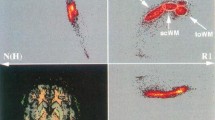Abstract
Reconstructing a topologically correct representation of the brain cortex surface from magnetic resonance images is important in several medical and neuroscience applications. Most previous methods have either made drastic changes to the underlying anatomy or relied on hand-editing. Recently, a new technique due to Shattuck and Leahy yields a fully-automatic procedure with little distortion of the underlying segmentation. The present paper can be considered as an extension of this approach to include arbitrary cut directions and arbitrary digital connectivities. A detailed analysis of the method’s performance on 15 magnetic resonance brain images is provided.
Acknowledgments
We thank Drs. Sinan Batman, John Goutsias, Susan Resnick, and Dzung Pham for their contributions. This work was supported in part by NSF/ERC grant CISST#9731748 and NIH/NINDS grant R01NS37747.
Access this chapter
Tax calculation will be finalised at checkout
Purchases are for personal use only
Preview
Unable to display preview. Download preview PDF.
Similar content being viewed by others
References
Z. Aktouf, G. Bertrand and L. Perroton, “A 3D-hole closing algorithm,” in 6th Int. Workshop on Discrete Geometry for Computer Imagery, 36–47, 1996.
G. Bertrand, “Simple points, topological numbers and geodesic neighborhoods in cubic grids,” Patt. Recog. Lett., 15:1003–1011, 1994.
G. Carman, H. Drury, and D. Van Essen, “Computational methods for reconstructing and unfolding the cerebral cortex,” Cerebral Cortex, 5:506–517, 1995.
A. Dale, B. Fischl, and M. Sereno, “Cortical surface-based analysis I & II,” NeuroImage, 9:179–207, 1999.
J.-F. Mangin, V. Frouinh, J. Regis, and J. Lopez-Krahe, “From 3D magnetic resonance images to structural representations of the cortex topography using topology preserving deformations,” J. Math. Imag. Vision, 5:297–318, 1995.
B. Natarajan, “On generating topologically consistent isosurfaces from uniform samples,” The Visual Computer, 11(1):52–62, 1994.
D. Shattuck and R. Leahy, “Topological refinement of volumetric data,” in Proc. of the SPIE, 3661:204–213, Feb. 1999.
D. Shattuck and R. Leahy, “Topologically constrained cortical surfaces from MRI,” in Proc. of the SPIE, 3979:747–758. Feb. 2000.
S. M. Resnick, A. F. Goldszal, C. Davatzikos, S. Golski, M. A. Kraut, E. J. Metter, R. N. Bryan, and A. B. Zonderman, “One-year age changes in MRI brain volumes in older adults”, Cerebral Cortex, 10(5): 464–472, 2000.
P. Teo, G. Sapiro, and B. Wandell, “Creating connected representations of cortical GM for functional MRI visualization”, IEEE Trans. Med. Imag., 16:852–863, 1997.
C. Xu, D. Pham, M. Rettmann, D. Yu, and J. Prince, “Reconstruction of the human cerebral cortex from MR images,” IEEE Trans. Med. Imag., 18(6):467–480, 1999.
D. Van Essen and J. Maunsell, “Two dimensional maps of cerebral cortex,” J. of Comparative Neurology, 191:255–281, 1980.
Author information
Authors and Affiliations
Editor information
Editors and Affiliations
Rights and permissions
Copyright information
© 2001 Springer-Verlag Berlin Heidelberg
About this paper
Cite this paper
Han, X., Braga-Neto, U., Prince, J.L., Xu, C. (2001). Graph-Based Topology Correction for Brain Cortex Segmentation. In: Insana, M.F., Leahy, R.M. (eds) Information Processing in Medical Imaging. IPMI 2001. Lecture Notes in Computer Science, vol 2082. Springer, Berlin, Heidelberg. https://doi.org/10.1007/3-540-45729-1_40
Download citation
DOI: https://doi.org/10.1007/3-540-45729-1_40
Published:
Publisher Name: Springer, Berlin, Heidelberg
Print ISBN: 978-3-540-42245-7
Online ISBN: 978-3-540-45729-9
eBook Packages: Springer Book Archive




